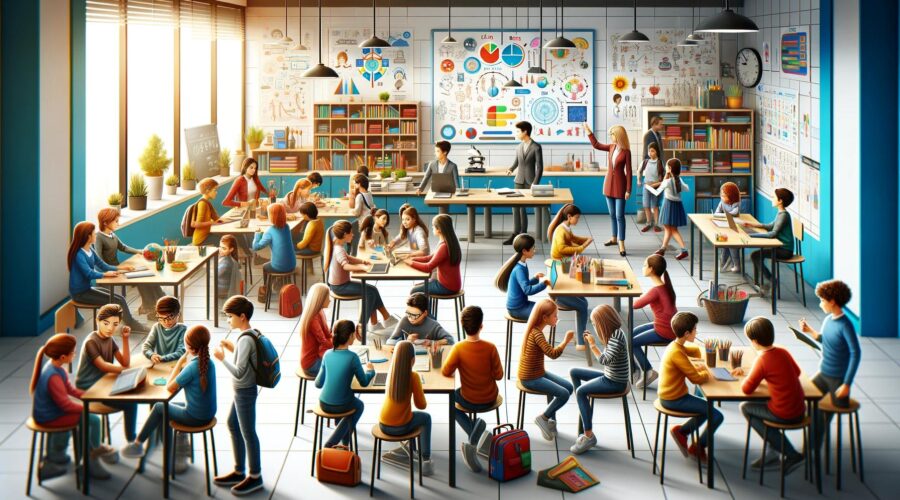In today’s diverse educational landscape, understanding and adapting to different learning styles is crucial for educators. Every student processes information differently, and acknowledging these differences can significantly enhance the learning experience. This article delves into various learning styles and provides strategies for teachers to accommodate them in the classroom.
Understanding Learning Styles
Learning styles refer to the various ways people learn and process information. The most widely recognized model categorizes these into three primary types: Visual, Auditory, and Kinesthetic.
Visual Learners
Visual learners understand and remember information better when it’s presented visually. They prefer images, diagrams, and written instructions. These students often think in pictures and benefit from visual aids like charts, graphs, and videos.
Auditory Learners
Auditory learners excel when information is presented through sound and speech. They benefit from lectures, discussions, and reading aloud. These learners tend to remember what they hear and follow spoken directions well.
Kinesthetic Learners
Kinesthetic learners are hands-on and learn best through movement and doing. They prefer activities where they can physically engage with the material, such as experiments, role-playing, or building models.
Theoretical Foundations of Learning Styles
The concept of learning styles has been a topic of significant interest and debate in the educational community. At its core, the theory of learning styles is based on the idea that individuals vary significantly in acquiring and processing information. One of the most influential models in this field is the VARK (Visual, Auditory, Reading/Writing, Kinesthetic) framework developed by Neil Fleming in the late 1980s. This model categorizes learners based on the sensory modalities they prefer to use when learning new information.
Visual learners, according to the VARK model, have a preference for seeing information, often in the form of graphs, charts, and diagrams. Auditory learners process information best through listening, while reading/writing learners strongly prefer interacting with textual content. On the other hand, Kinesthetic learners thrive with hands-on experiences and learning by doing.
Critics of the learning styles theory argue that there is a lack of empirical evidence supporting the effectiveness of tailoring teaching methods to individual learning styles. Despite this, the concept remains popular among educators due to its intuitive appeal and emphasis on individual differences in learning.
It’s important to note that learning styles are not fixed traits but rather preferences that can evolve over time. Understanding these styles is not about pigeonholing students into categories but rather about acknowledging and embracing diversity in learning approaches. This perspective encourages educators to create flexible and varied instructional methods that can cater to a wide range of learners, promoting a more inclusive and effective educational environment.
Incorporating Multiple Learning Styles in Teaching
Incorporating a mix of teaching methods that cater to all learning styles can be challenging, but it’s vital for an inclusive classroom. Here are some strategies:
Diversifying Instructional Methods
- Visual Strategies: Incorporate charts, diagrams, and visual organizers in lessons. Use color coding to highlight important information and encourage students to create mind maps.
- Auditory Strategies: Include storytelling, discussions, and debates in your teaching. Use mnemonic devices and encourage verbal summarization of content.
- Kinesthetic Strategies: Implement hands-on activities like experiments, crafts, and physical games. Allow students to demonstrate concepts through movement or building.
Utilizing Technology
Leverage technology to create a multi-sensory learning environment. Use educational software that includes interactive elements, videos, and audio clips to cater to different learning preferences.
Role of Technology in Catering to Learning Styles
In the contemporary educational landscape, technology plays a pivotal role in addressing diverse learning styles. Digital tools and educational software offer multifaceted learning experiences that can be tailored to individual preferences, thus bridging the gap between different types of learners.
For visual learners, technology offers a plethora of opportunities. Interactive whiteboards, educational videos, and graphic organizing software provide dynamic visual aids that enhance comprehension and retention. Tools like infographics and virtual reality can turn abstract concepts into tangible visual experiences, making learning more engaging and effective for these students.
Auditory learners, on the other hand, benefit from podcasts, audiobooks, and digital storytelling tools. These resources allow them to absorb information through listening, which can be particularly helpful in subjects like language arts and history. Voice-to-text software also assists auditory learners by converting spoken language into written text, thus supporting their learning process.
Kinesthetic learners, who learn best through touch and movement, can take advantage of interactive simulations and educational games. These technologies provide hands-on experiences and allow students to learn by doing, which is crucial for understanding and retaining new concepts. Additionally, augmented reality (AR) and virtual labs offer immersive experiences where kinesthetic learners can engage with materials in a virtual space, making abstract concepts more concrete and understandable.
Furthermore, technology facilitates personalized learning paths, enabling students to learn at their own pace and style. Adaptive learning software, for example, adjusts content based on individual performance and learning preferences, ensuring that each student receives tailored support.
Technology enriches the educational environment by offering diverse, flexible, and interactive learning experiences. It caters to different learning styles, making education more accessible and effective for every student, thereby transforming the way knowledge is imparted and absorbed in the digital age.
Creating an Inclusive Classroom Environment
An inclusive classroom respects and acknowledges the diversity of learning styles:
Encouraging Peer Learning
Facilitate group activities where students can learn from each other. Each student’s unique approach to learning can contribute to the group’s understanding.
Personalizing Learning
Where possible, offer choices on how to complete assignments. Allow students to pick topics or presentation methods that play to their strengths.
Continuous Assessment and Feedback
Regularly assess how well students are grasping the material and adjust your teaching methods accordingly. Use a variety of assessment methods, such as written tests, oral presentations, and practical demonstrations.
Overcoming Challenges in Adapting Teaching Styles
While adapting to different learning styles presents challenges, here are some strategies to overcome them:
Balancing Different Needs
Strive to balance the needs of various learners without favoring one style over another. This might involve combining different teaching methods within a single lesson.
Teacher Training
Continuous professional development can help teachers learn new strategies for accommodating different learning styles. Workshops and seminars can provide fresh ideas and approaches.
Collaboration with Colleagues
Sharing experiences and strategies with colleagues can be invaluable. Collaborative planning can lead to more diverse and effective teaching approaches.
Future Trends in Education and Learning Styles
The future of education is poised to be profoundly influenced by evolving understandings of learning styles and the integration of technology. As we advance, the focus is shifting towards a more personalized, student-centered approach to learning, underpinned by emerging technologies and pedagogical strategies.
One significant trend is the increasing use of artificial intelligence (AI) and machine learning to tailor educational experiences to individual learning styles. AI systems are being developed to analyze students’ learning patterns and adapt content delivery to maximize engagement and effectiveness. This adaptive learning technology promises to offer a more customized educational journey, catering to the unique needs and preferences of each student.
Another trend is the growing emphasis on experiential learning, which aligns with the kinesthetic learning style. Future educational models are likely to incorporate more hands-on, practical experiences facilitated by virtual and augmented reality. These technologies can create immersive learning environments that simulate real-world scenarios, providing learners with valuable practical experience and a deeper understanding of theoretical concepts.
Moreover, the future of education may see a more holistic approach to learning styles, moving beyond the traditional VARK model. Educators and researchers are exploring the integration of emotional and social learning aspects, recognizing that effective learning also involves understanding students’ emotional intelligence and social contexts.
In essence, future educational trends will likely be characterized by a blend of technology, personalized learning experiences, and a broader understanding of learning styles. This evolution aims to make education more adaptable, engaging, and effective for learners in an increasingly digital and diverse world.
Conclusion
Adapting to different learning styles in the classroom is not just a teaching strategy; it’s a necessity in today’s diverse educational environment. Educators can create more engaging, effective, and inclusive learning experiences by recognizing and accommodating the unique ways in which students learn. This approach benefits students and enriches the teaching practice, making education a more fulfilling and impactful journey for everyone involved.

